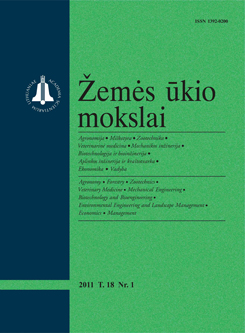Žemės ūkio mokslai / Agricultural Sciences
WHAT?
 ISSN 1392-0200 |
2006 m. Nr. 2 Measures suppressing the development of fungi on
Lupinus luteus L.
During the period 2001–2003, in research facilities of the Vokė Branch of the Lithuanian Institute of Agriculture, investigations in order to determine the impact of various seed treatment preparations (Vitavax, Fundazol, Panoctine, Maxim, Maxim Star, Raxil) upon micromycetes detected on lupine seeds and in soil were performed. The prevailing soils were sandy loam on carbonated fluvioglacial eluviated gravel (JDp) Haplic Luvisols (Lvh). The Lithuanian variety ‘Augiai’ of Lupinus luteus was grown. Micromycetes were investigated on seeds, roots, aboveground parts of plants and in rhizosphere soil.
The biological efficiency of the preparations Maxim 2.0 l t-1; Raxil 1.5 kg t-1; Maxim Star 1.5 l t-1 which suppressed the development of Colletotrichum gloeosporioides and other fungi as well as stimulated the growth of lupines should be noted. Under the action of Vitavax, Panoctine and Maxim star the number of fungal species on seeds reduced to 1–2. Treatment of seeds with a chemical preparations had a different impact on the spreading of various groups of microorganisms in plant rhizosphere. The number of fungi colony forming units (cfu) decreased when seeds were treated with Vitavax, Fundazol and Maxim, while fungal species diversity decreased only under the action of Maxim. The number of Streptomyces and some mineral nitrogen assimilating bacteria decreased when seeds were treated with Panoctine, Maxim star and Raxil. In another trial where Vitavax 200 FF 2,0 l t-1 was used for seed treatment, lupines were sprayed with the following fungicides: Sportak 45% 1.0 l ha-1; Ronilan DF 50% 1.0 kg ha-1; Bravo 2.0 l ha-1; Juventus 1.25 l ha-1; Folicur BT 25.5% 1.0 l ha-1. The applied fungicides did not protect the stems of lupines ‘Augiai’ from infection by Colletotrichum gleosporioides and other fungi. Roots of plants sprayed with the above-mentioned fungicides were somewhat less infected; the amount of Alternaria alternata, Pythium intermedium, Thielaviopsis basicola fungi reduced. The number of fungal species was lower on roots, stems and new yield seeds after application of the fungicide Bravo. Sportak 45% and Juventus were less efficient. Keywords: Lupinus luteus, micromycetes, infection, seed treatment preparations, fungicides |
Numeriai:
2012 - T.19 Nr.1 2011 - T.18 Nr.1, Nr.2, Nr.3, Nr.4 2010 - T.17 Nr.1-2, Nr.3-4 2009 - T.16 Nr.1-2, Nr.3-4 2008 - T.15 Nr.1, Nr.2, Nr.3, Nr.4 2007 - T.14 Nr.1, Nr.2, Nr.3, Nr.4, Nr.Priedas 2006 Nr.1, Nr.1.Priedas, Nr.2, Nr.3, Nr.4 2005 Nr.1, Nr.2, Nr.3, Nr.4 2004 Nr.1, Nr.2, Nr.3, Nr.4 2003 Nr.1, Nr.2, Nr.3, Nr.4 2002 Nr.1, Nr.2, Nr.3, Nr.4 2001 Nr.1, Nr.2, Nr.3, Nr.4 |